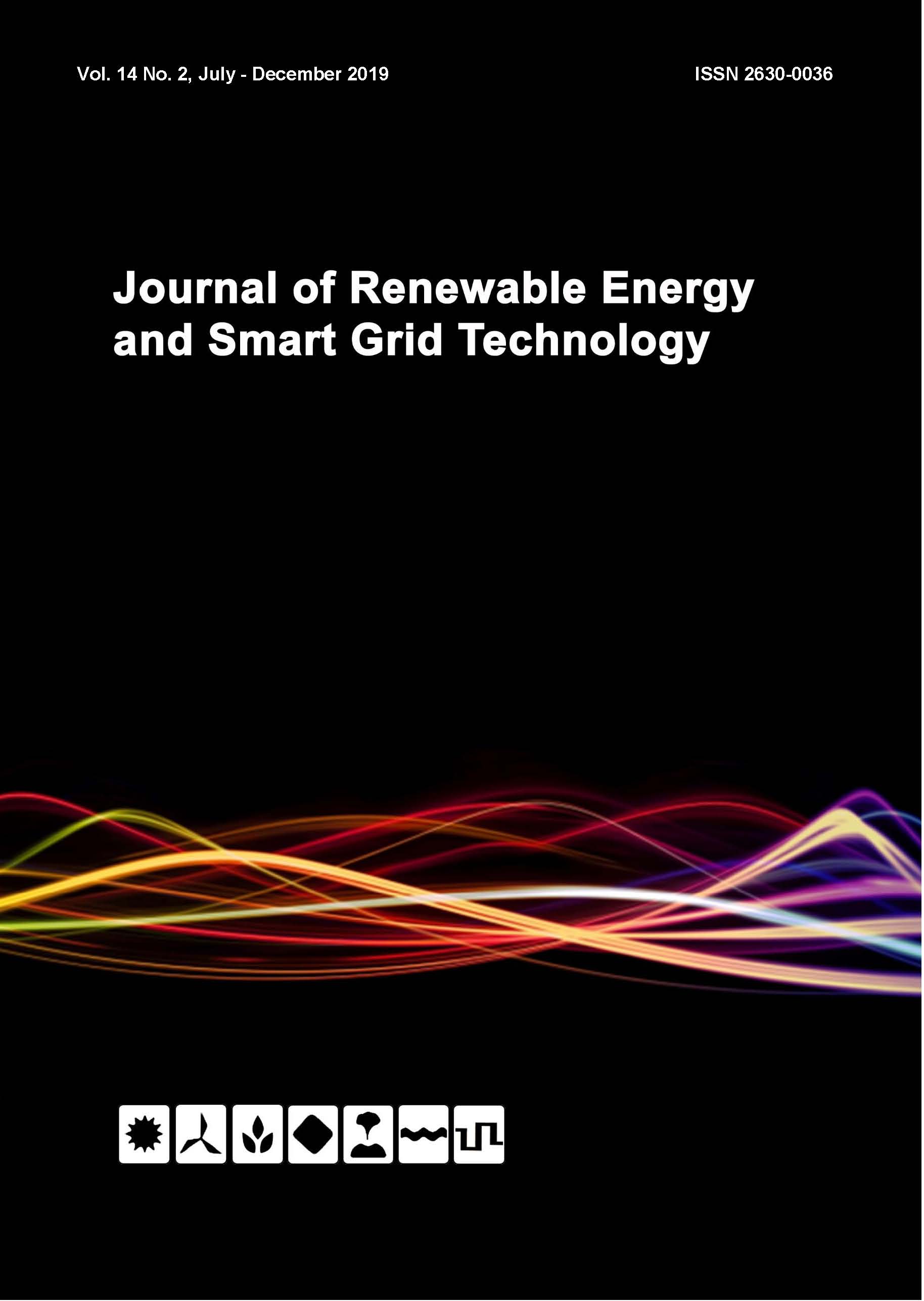A technique for mapping hourly global solar near infrared radiation from satellite data
Keywords:
Solar near infrared radiation, Satellite data, MappingAbstract
This paper presents a technique for mapping hourly global solar near infrared radiation (SNIR) from 0.695um to 2.80 um using MTSAT-1R satellite data. A simple radiative balance model is used to relate an atmospheric reflectance as seen by the satellite to an equivalent reflectance obtained from pyranometer measurements in the SNIR band. The tuned and calibrated atmospheric reflectance from satellite data is then used to estimate surface SNIR irradiance and the results are shown as SNIR maps. Statistics for monthly average of hourly SNIR irradiance are presented for Thailand using five years (2009-2013) of satellite data.
References
[2] Muneer T, (2004). Solar Radiation and Daylight Models. Elsevier Butterworth-Heinemann, Oxford, UK.
[3] Gates DM, Murcray DG, Shaw, CC, Hevbold RJ, (1958). Near infrared measurements by balloon to an altitude of 10,000 feet. J. Opt. Soc. Am., 43, 1010-1016.
[4] Bolsenga SJ, (1976). Near infrared radiation in Northern Green land. J. Appl. Meteorol. 6, 449 – 451.
[5] Weiss A, Norman, JM, (1985). Partitioning solar radiation into direct and diffuse, visible and near infrared components. Agric. Forest Meteorol. 34, 2015-2013.
[6] Escobedo JF, Gomes EN, Oliveire AP, Soares J, (2009). Modeling hourly and daily of UV, PAR and NIR to global solar radiation under variation sky conditions at Botucatu, Brazil. Appl. Energy 86, 299 – 309.
[7] Rossi TJ, Escobedo JF, Dos Santos CM, Rossi LR, Da Silva MBP, Dal Pai Enzo, (2018). Global diffuse and direct solar radiation of the infrared spectrum in Botucatu/SP/Brazil. Renewable and Sustainable Energy Reviews 82, 448-459.
[8] Janjai S, Buntung S, Wattan R, Masiri I, (2010). Mapping solar ultraviolet radiation from satellite data in a tropical environment. Remote Sensing and Environment 114, 682-691.
[9] Choosri P, Janjai S, Nunez M, Buntoung S, Charuchittipan D, (2017). Mapping diffuse photosynthetically active radiation from satellite data in Thailand, Advances in Space Research 60, 2345-2354.
[10] JMA, (2009). Conversion table of satellite data. Japanese Meteorological Agency, Tokyo, Japan.
[11] Cole RJ, (1976). Direct solar radiation data as input into mathematical models describing the thermal performance of buildings – II. Development of relationships. Build. Environ. 11, 181-186.
[12] Janjai J, Laksanaboonsong J, Nunez M, Thongsathiya A, (2005). Development of a method for generating operational solar radiation maps from satellite data for a tropical environment. Sol. Energy 78, 739-751.
[13] Janjai S, Pankaew P, Laksanaboonsong J, (2009). A model for calculating hourly global solar radiation from satellite data in the tropics. Appl. Energy 86,1450 – 1457.
[14] Tanre´ D, Deroo C, Duhaut P, Herman N, Morcrette JJ, Deschamps PY, (1986). Simulation of the satellite signal in the solar spectrum. Techical Report, Laboratorire d´ Optique Atmospherique, Université des Science et Technique de Lille, 59655 Villeneuve d´ Ascq Cedex, France.
[15] Exell RHB, (1984). Mapping solar radiation by meteorological satellite. Renew. Energy Rev. J. 6, 27 – 39.
[16] Schillings C, Mannstein H, Meyer R, (2004). Operational method for deriving high resolution direct normal irradiance from satellite data. Sol. Energy 76, 475 – 484.
[17] Tarpley JD, (1979). Estimating incident solar radiation at the surface from geostationary satellite data. J. Appl. Meteorol. 18, 1172-1181.
[18] Gautier C, Diak G, Masse S, (1980). A simple physical model to estimate incident solar radiation at the earth surface from GOES satellite data, J. Appl. Meteorol. 36, 1005 – 1012.
[19] Nunez M, The development of a satellite-based insulation model for the tropical western Pacific Ocean. Int. J. Climatol. 13 (1993) 607 – 627.
[20] Polo J, Zarzaleja LF, Ramírez L, (2008). Solar radiation derived from satellite images, in: V. Badescu (Ed.), Modelling solar radiation at the earth’s surface. Springer, Berlin, 449 – 461.
[21] Martins FR, Pereira EB, Abreu SL, (2007). Satellite-derived solar resource maps for Brazil under SWERA project. Sol. Energy 81 (2007) 517 – 528.
[22] Vonder HT, Raschke E, Bandeen W, Pasternak M, (1973). Measurements of solar energy reflected by the earth and atmosphere from meteorological satellite, Sol. Energy 14, 175 – 184.
[23] Pinker RT, Laszlo I, (1992). Modeling surface solar irradiance for satellite applications on a global scale. J. Appl. Meteorol. 31, 194-211.
[24] Masiri I, Nunez M, Weller E, (2008). A 10-year climatology of solar radiation for the Great Barrier reef; implications for recent mass coral bleaching events. J. Remote Sens. 29, 4443-4462.
[25] Leckner B, (1978), The spectral distribution of solar radiation at the earth’s surface-elements of a model. Sol. Energy 20, 143-150.
[26] Iqbal M, (1983). An Introduction to Solar Radiation, Academic Press, New York.
[27] Holben BN, Eck TF, Slutsker I, Tanre´ D, Buis JP, Setzer A, Vermote E, Reagan JA, Kaufman YJ, Nakajima T, Lavenu F, Jankowiak I, Smirnov A, (1998). AERONET- A Federated Instrument Network and data archeive for aerosol characterization. Remote Sens. Environ. 60, 1-16.
[28] Moody EG, King MD, Schaaf CB, Hall CB, Platnick S, (2007). Northern Hemisphere five-year average (2000-2004) spectral albedos of surfaces in the presence of snow: statistic computed from Terra MODIS land products. Remote Sens. Environ. 111, 337 – 345.
[29] Mayer B, Kylling A, (2005). Technical note: The libRadtran software package for radiative transfer calculations – description and examples use. Atmos. Chem. Phys. 5, 1855 – 1877.
[30] Stephens GL, (1994). Remote sensing of the lower atmosphere: an introduction. Oxford University Press Inc., Oxford.
Downloads
Published
How to Cite
Issue
Section
License
All copyrights of the above manuscript, including rights to publish in any media, are transferred to the SGtech.
The authors retain the following rights;
1. All proprietary rights other than copyright.
2. Re-use of all or part of the above manuscript in their work.
3. Reproduction of the above manuscript for author’s personal use or for company/institution use provided that
(a) prior permission of SGtech is obtained,
(b) the source and SGtech copyright notice are indicated, and
(c) the copies are not offered for sale.









